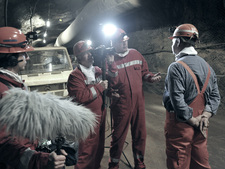Rescue exercise in the Konrad mine: In March on ZDF
Cities have fire fighters, mines have mine rescue teams. Requirements on rescue teams are high, participation is voluntary. The ZDF broadcast a programme about mine rescue teams. For this purpose, it also filmed in the Konrad mine.

![]() Interview with the leader of the mine rescue team
Interview with the leader of the mine rescue team
The mine rescue team assist in case of mine accidents, they save and recover injured miners underground and fight fires in mines. No mine may be operated in Germany without a functioning mine rescue team. In case of emergency, the mine rescue teams of different mines also assist each other.
Mental and physical fitness as a prerequisite
Of particular importance are the physical fitness and the inner calmness of the men. Not only must each team member prove their high physical fitness in general but in particular before each exercise. Regular theoretical and practical training serves preparedness. Mental strength needs to be considered and tested, as well. For this purpose, the mine rescue team exercise, among others, in the breathing exercise facility in Salzgitter-Engerode which had been utilised by the Salzgitter ore mining’s rescue team until 1975. The facility simulates the world underground. There are narrow rooms and low galleries which can be fogged, if required. The rescue team member must pass through this – carrying about 15 kg of heavy respiratory protective equipment.
Special features in the case of Konrad
One special feature of the Konrad mine rescue team is the mountain rescue team. That sounds like a contradiction: You need a mountain rescue team underground? Its members are especially trained to rescue persons from rough terrain, with the help of rope and carabiner. That needs to be trained. As training ground, the Konrad mine rescue team also use unorthodox buildings such as the keep of the Lichtenberg castle ruin in Salzgitter.
Exercise with scenario: Fire underground

![]() The rescuers have to wear heavy breathing apparatus
The rescuers have to wear heavy breathing apparatus
To be able to present the rescue team’s work as a film, an exercise was staged that was accompanied by a ZDF film team with a camera. The following scenario was developed: A vehicle is sitting in a gallery underground and has caught fire. The miner’s escape route is cut off by the burning vehicle, because the gallery is a cul-de-sac and he would have to pass the burning vehicle.
Waiting for the mountain rescue team
The single escape route is a long tube connecting two levels. With his oxygen self-rescuer, the trapped miner sits down calmly at the wall and waits, while the mountain rescue team are preparing for their work, 40 metres above him. On account of the toxic fumes to be expected, which are simulated by a fog machine, the rescuers have to wear heavy breathing apparatus, which makes the recovery even more difficult. One team member lets himself down on a rope via the tube and carries the waiting miner up at his own body with the help of the corresponding equipment.
After six hours of filming the pictures are taken.
State of 2012.04.02

